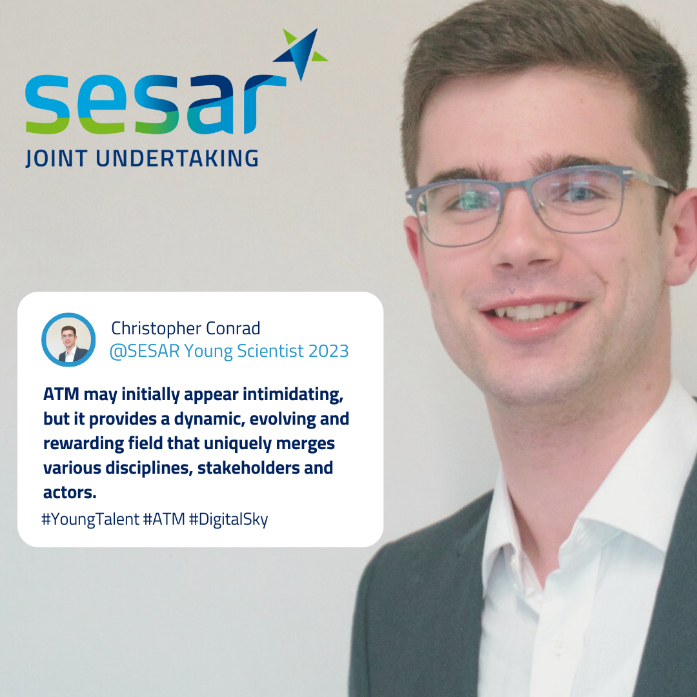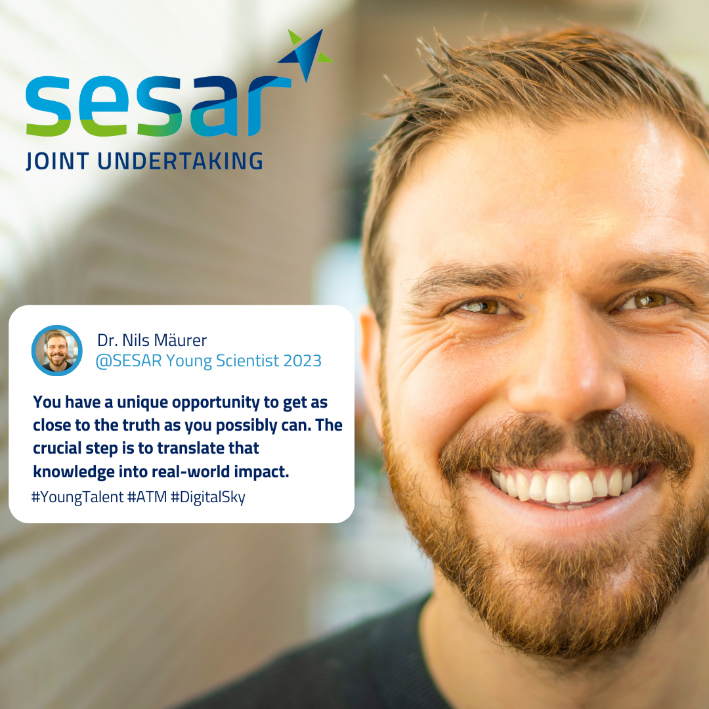Challenges including increased digitalisation, the integration of new vehicles and emerging technologies inspired the winners of the 2023 SESAR Young Scientist awards, Dr Nils Mäurer and Christopher Conrad, to push the boundaries of aviation research in unique and innovative ways. Rewarding scientific excellence in postgraduate and undergraduate research, the annual awards draw attention to their findings and serve as a stepping stone to further career development.
 “The ATM sector is on the brink of a digital revolution, marked by a growing interest in intelligent solutions, digitalisation, and the introduction of advanced air mobility (AAM) and unmanned traffic management (UTM),” says Christopher Conrad, Cranfield University. “ATM modernisation requires new standards, regulations, processes and technologies supported by substantial infrastructure development.”
“The ATM sector is on the brink of a digital revolution, marked by a growing interest in intelligent solutions, digitalisation, and the introduction of advanced air mobility (AAM) and unmanned traffic management (UTM),” says Christopher Conrad, Cranfield University. “ATM modernisation requires new standards, regulations, processes and technologies supported by substantial infrastructure development.”
Christopher picked up the top prize among the student’s category for his data model for managing vertiport traffic along with intelligent solutions to effectively utilise this data infrastructure. Vertiports accommodate vertical take-off and landing (VTOL) vehicles, operating on-demand aerial services within dynamic airspace structures. Capacity constraints call for strict flight envelops and reliable data, for example to monitor hyperlocal micro-weather variations and uncooperative aerial systems nearby. “My work explores safe, shielded and explainable algorithms to improve the safety, reliability and trustworthiness of AI-based solutions for UTM,” he says. “It also emphasises the importance of integrating AAM within a multimodal transportation framework to achieve a more efficient mobility ecosystem.”
Cyber challenge
Observing a noticeable absence of robust security measures in communications, navigation and surveillance (CNS) and ATC communications while working at the German Aerospace Center (DLR), Dr. Nils Mäurer, University of the Bundeswehr Munich/Airbus chose to address these deficiencies in his PhD thesis. He took the top PhD prize for his research on cybersecurity measures in the next generation of aeronautical communications, specifically within the L-band digital aeronautical communications system (LDACS). “50 years’ ago, meddling with CNS required the resources of a large organisation or a nation-state actor. Today, the accessibility of hardware, open-source repositories on platforms like GitHub, and instructional videos on YouTube has lowered the barriers, enabling anyone to potentially interfere with aeronautical communications.” Nils’ sound and rigorous research including design, simulation, validation, lab work and flight trials received special praise from the judges.
 The outcome of Nils’ research has been incorporated into a LDACS's official standard. “Throughout my PhD, we conducted flight trials to demonstrate the efficacy of the cybersecurity measures I proposed. Our testing included the secure and efficient transmission of ground-based augmentation system landing system (GLS) data via LDACS, crucial for the safe automatic landings of aircraft. This represents a substantial security enhancement compared to the currently employed open VDB (VHF data broadcast) datalink. Implementing these same security measures on legacy systems today would render most cyberattacks on aeronautical communications unfeasible.”
The outcome of Nils’ research has been incorporated into a LDACS's official standard. “Throughout my PhD, we conducted flight trials to demonstrate the efficacy of the cybersecurity measures I proposed. Our testing included the secure and efficient transmission of ground-based augmentation system landing system (GLS) data via LDACS, crucial for the safe automatic landings of aircraft. This represents a substantial security enhancement compared to the currently employed open VDB (VHF data broadcast) datalink. Implementing these same security measures on legacy systems today would render most cyberattacks on aeronautical communications unfeasible.”
He warns the absence of robust cybersecurity measures poses a tangible threat to aviation safety today, and says the urgency of addressing this issue cannot be overstated. “Never be afraid to speak the truth,” he advises young researchers just embarking on their career. “You have a unique opportunity to get as close to the truth as you possibly can. The crucial step is to translate that knowledge into real-world impact.”
Encouraging others to innovate, Christopher Conrad counsels that while “ATM may initially appear intimidating,” it provides “a dynamic, evolving and rewarding field that uniquely merges various disciplines, stakeholders and actors.” He says this is a particularly exciting time to enter the industry, and UTM stands out as an exceptional opportunity to harness innovation for societal benefit.
Read more about the 2023 SESAR Young Scientist Award
